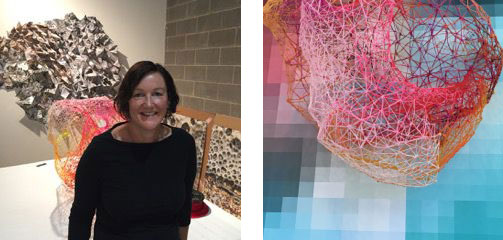Jodi Stuart will be in the 3-D Studio April 21 and 22.
Olivia Davies: What will your demonstration at the DAM look like? What can visitors expect?
Jodi Stuart: I will be using a 3-D pen, demonstrating using a work in progress. I will have some finished works on display in the 3-D Studio, as well as have some smaller samples, which visitors can pick up and look at in close detail. It’s a very tactile medium, so I would like visitors to be able to handle the samples, feel the lightness of the material, and the texture of the filament. The plastic forms are delicate but surprisingly strong.
OD: Can you tell us a little bit about your process?
JS: Using the 3-D pen is a slow process, much like knitting or crochet. It involves for me melting plastic filament over a support such as a PVC pipe-fitting or metal bowl. Then once the structure is in place I work free-hand with the material to build up layers and blend colors. The 3-D pen itself looks kind of like a mechanized hot-glue gun. It melts and extrudes the plastic filament which quickly hardens at room temperature.

Forma Futura (detail), 2016. 120” x 72” 32” 3-D pen formed ABS plastic, digital print on adhesive vinyl. Image - Wes Magyar.
OD: What inspired you to start using 3-D printing pens in your work?
JS: I was in the process of learning the 3-D software program Blender with a view to making 3-D printed objects, when I became fascinated with the wire-frame editing view. I loved to zoom in and through the vertices on screen. I wanted to try and create physical objects that mimicked the computer-generated ones. Serendipitously, around that same time, a 3-D pen product came up on my product suggestion list via Amazon, so I purchased one and tried it. At first I made forms to mimic the computer-generated forms that I had previously made in Blender (Image below).
In those first experimental pieces, I felt that the shadows they cast most closely resembled the wire-frame effect, so initially I was interested in the shadows as much as the plastic forms. As I became more experienced in using the plastic filaments, I became more interested in color, blending and creating gradation. Eventually in order to increase the scale and strength of the pieces I started to use objects such as PVC pipe joints and large metal bowls as molds in my process.
OD: How does the use of digital media inform your artistic practice?
JS: I have always been interested in ideas around the body and technology. Be it the insidious nature of digital media, or predictions that technology will someday ‘replace’ the body. In some ways my practice involves working through my own deep ambivalence towards digital media. For example, since purchasing my first 3-D pen via an Amazon suggestion, this product has had an incredible impact on my work, making it possible for me to realize ideas that had previously been beyond my grasp. But, at the same time, it is disturbing that an algorithm can know my search history and preferences so well that it can predict my future! Or was it a prediction? Maybe it was the power of suggestion? My art practice often acts as a respite from feeling manipulated by digital culture, through making very labor intensive, tactile works using high-tech tools and materials. In my practice I oscillate between the desire to re-insert the body into virtual experience and/or to materialize real objects from the virtual.



